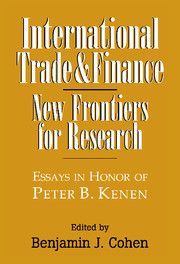Book contents
- Frontmatter
- Contents
- List of contributors
- Introduction
- 1 The practical theorist: Peter Kenen's contribution to international economics
- I International trade theory
- II International monetary theory
- 5 Exchange rate regimes and international trade
- 6 Exchange rates and investment response in Latin America
- 7 Optimum currency areas and exchange rate volatility: Theory and evidence compared
- 8 Optimum currency area theory: Bringing the market back in
- III Applied policy analysis
- Index
6 - Exchange rates and investment response in Latin America
Published online by Cambridge University Press: 11 September 2009
- Frontmatter
- Contents
- List of contributors
- Introduction
- 1 The practical theorist: Peter Kenen's contribution to international economics
- I International trade theory
- II International monetary theory
- 5 Exchange rate regimes and international trade
- 6 Exchange rates and investment response in Latin America
- 7 Optimum currency areas and exchange rate volatility: Theory and evidence compared
- 8 Optimum currency area theory: Bringing the market back in
- III Applied policy analysis
- Index
Summary
Introduction
The idea that countries should limit the movements of nominal or real exchange rates is a theme that arises in policy discussions for both industrialized and developing economies. One channel for exchange rate effects is via changes in producer profitability, which also can drive real investment activity. Endogeneity of sectoral investments has clear and potentially strong implications for overall sectoral growth and aggregate GDP.
The potential implications of nominal and real exchange rates for investment has been a theme often considered in the thoughtful work of Peter Kenen. In the mid-1990s, Kenen (1994) restated his concerns about exchange rate and investment linkages, arguing that “uncertainty about future exchange rates has probably affected capital formation in ways that reduce economic efficiency, and that same uncertainty may also explain why trade balances have adjusted sluggishly to exchange rate changes.” Although Kenen's contributions are oriented mainly toward industrialized countries, there clearly are strong developing country parallels. Fluctuations and cycles in real exchange rates often are observed, and these steep movements in exchange rates can likewise slow capital formation and reduce economic efficiency.
In the present essay I focus on the link between real exchange rate movements and investment activity in Latin America. For individual producers, investment responds to exchange rates by altering the expected marginal profitability of capital (Campa and Goldberg, 1996).
- Type
- Chapter
- Information
- International Trade and FinanceNew Frontiers for Research, pp. 157 - 183Publisher: Cambridge University PressPrint publication year: 1997
- 2
- Cited by

